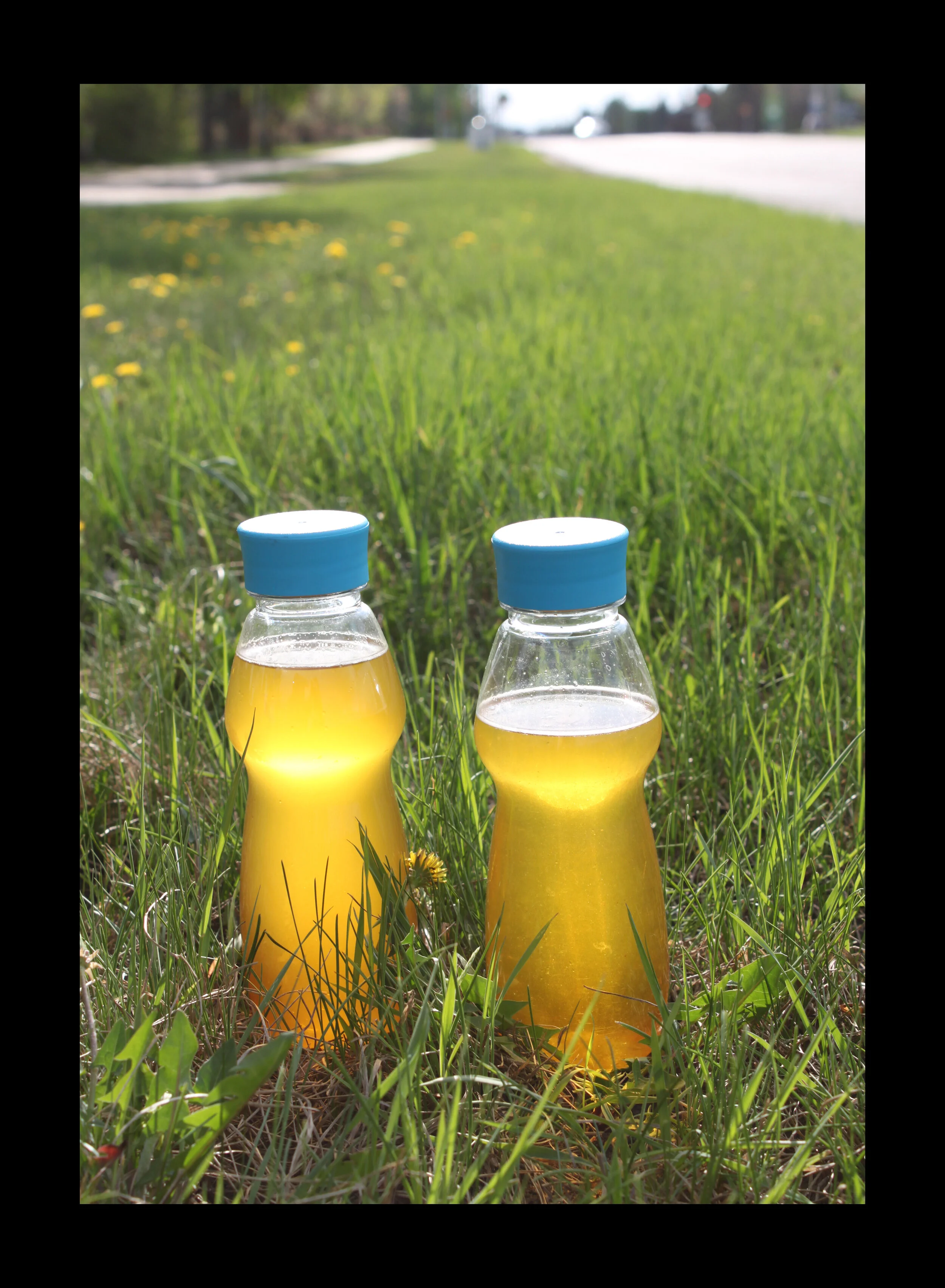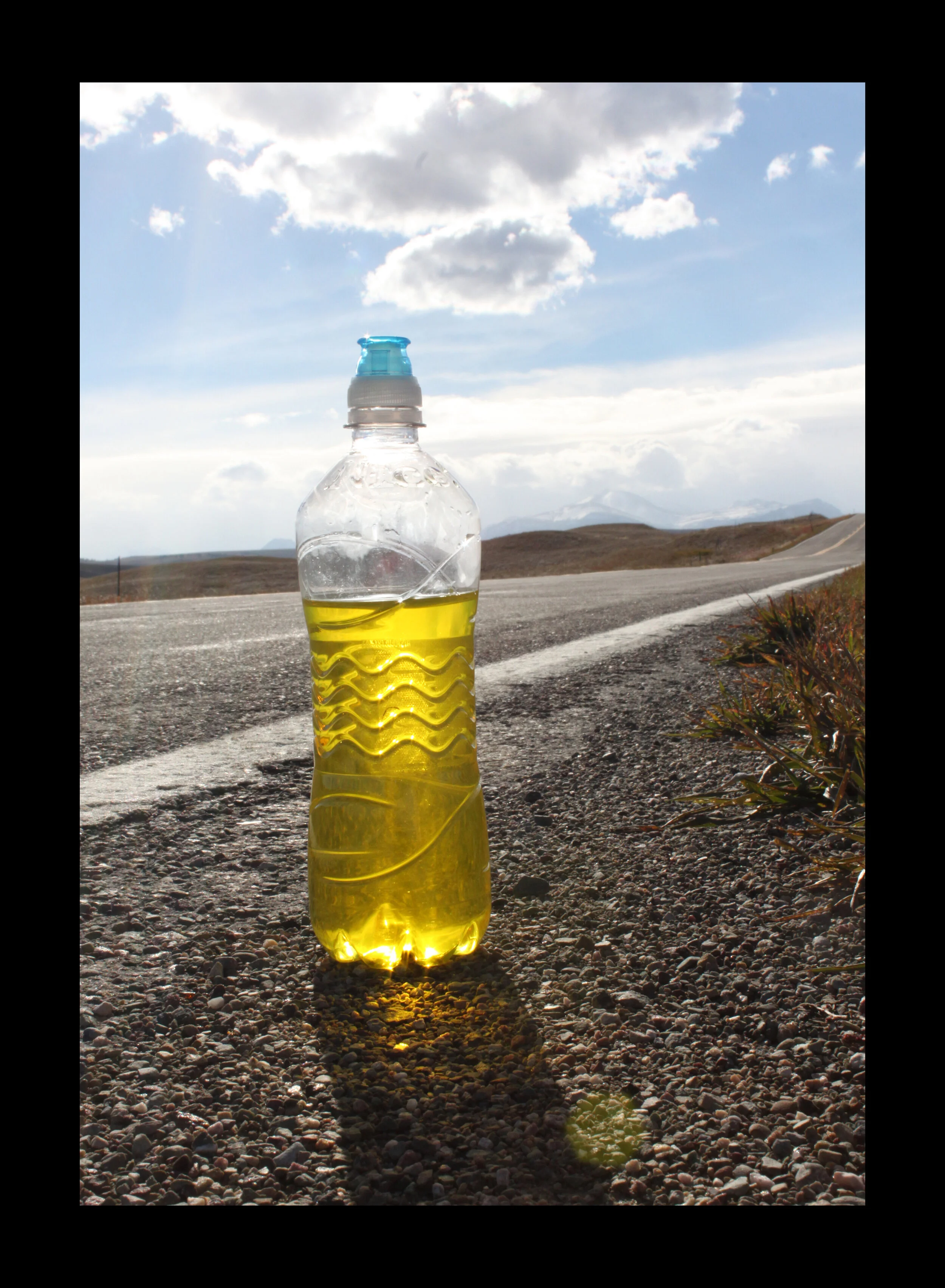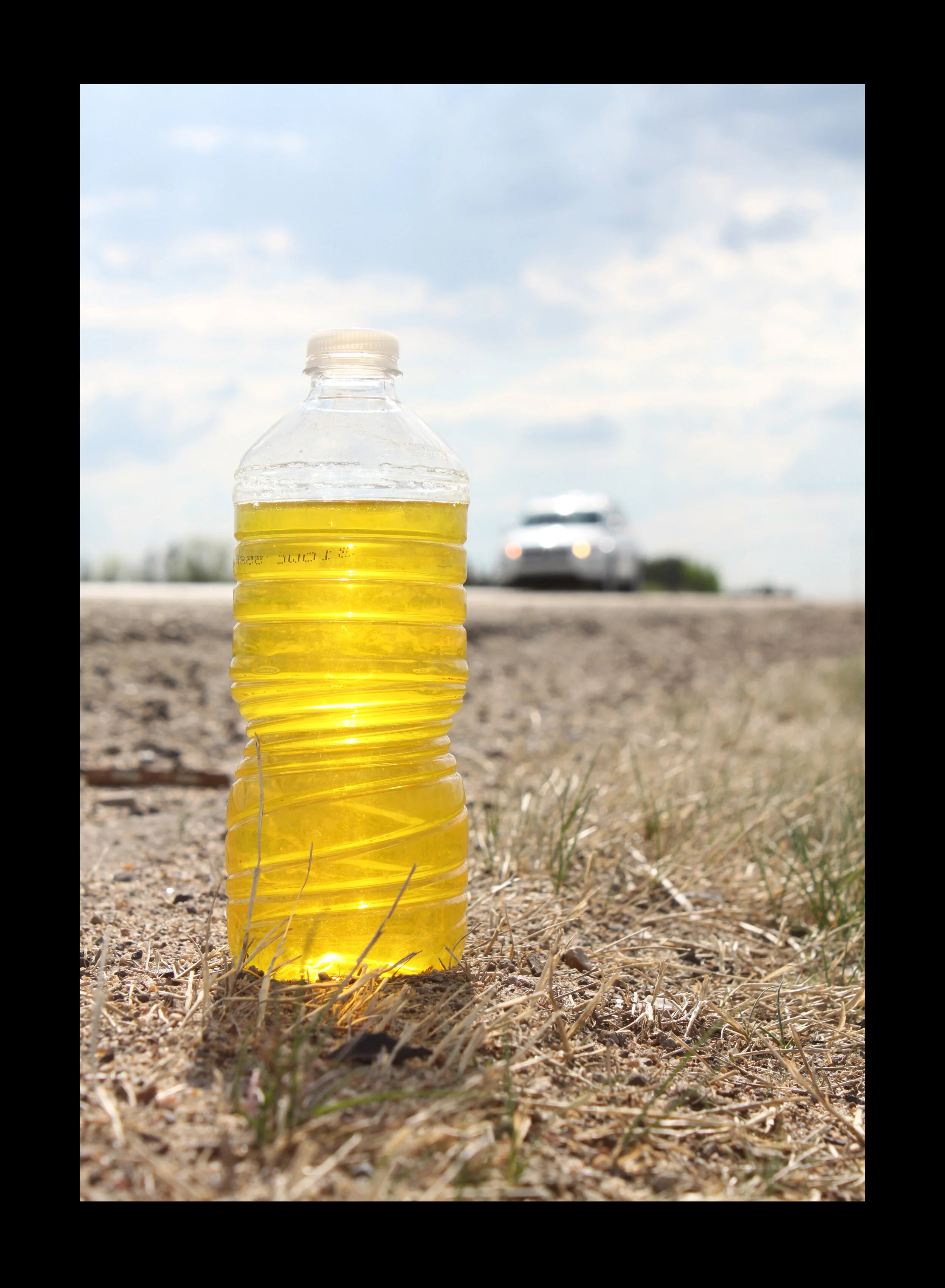Trucker Bombs
2014
I drive a lot. Everywhere. Road trips; pleasure trips, business trips. I get most of my deepest, most creative, best thinking done when I drive. I love to watch the landscape slip by and think of it as washing over my brain, cleaning out all the crap from the nooks and crannies and resetting it.
While I am driving, on long stretches of highway, I often see what are known as “trucker bombs” – bottles of urine hurled to the side of the road from moving vehicles, the driver apparently too lazy, too hurried or too weak-bladdered to stop and seek out a bathroom.
The proliferation of trucker bombs in recent years says a lot about the state of the trucking industry, the oil industry, our growing cities and insatiable consumer culture, and driving conditions – and by extension, our capitalist system. With the decimation of trucker’s unions, overworked non-unionized truckers who are paid only for time they spend driving or, worse, paid by the shipment, are under pressure to drive longer and longer hours. More oil development, more construction and more products being shipped means more trucks and more miles to drive, while inadequate numbers of rest stops and roadside pull outs for trucks to safely stop at mean less options for stopping.
But they also say something about male privilege, abuse of power, and territory marking. Men are not the only people capable of littering and they are not the only ones driving commercial trucks. But obviously it is only men who can pee in a bottle while they are driving; by leaving these golden, glowing little lanterns of piss by the side of the highway they are effectively staking out their territory and terrorizing the rest of us who use the roads, not to mention those whose job it is to clean them up.
As a series of small actions, when driving on road trips (to and from Saskatoon, Calgary, Edmonton, Minnesota, etc.), I have started creating my own trucker bombs. Making sure I am carrying sealable, disposable drinking containers of water, I drive towards my destination until I need to urinate. I then do what I can to approximate the same series of actions that a man undertakes to create a trucker bomb. As a woman with very different physiology, however, it is a much more awkward and time-consuming process. I slow down and stop the car by the side of the road. Putting on my hazard lights, I get out of the car, go to the passenger side, open front and back passenger doors for shelter from the eyes of passing motorists, remove my underwear, place a funnel against my crotch, and squat into a bottle.
After the whole process I document the result and get back on the road, keeping the bottle until I can dispose of it properly.
The action is awkward, pathetic, abject; meant to contrast against the cavalier, macho act as performed by male drivers. Even the violence implied in the name – trucker bomb (or torpeedo) is extremely masculine, powerful, and erases the patheticness and emasculation inherent in a system that forces men to resort to pissing in plastic bottles and removes their agency to take a fucking potty break. Trucker bombs are the male driver’s way of re-asserting their power and reminding every other driver on the road of their supremacy.
By presenting the photos as beautiful objects, I want to feminize them; domesticate them. They are like religious icons, stained glass windows, amulets, jewels in the sun. My trucker bombs are powerful but for their beauty and not their violence.
As beautiful, carefully crafted images presented in slick lightboxes, they are also like commercial advertisements, subtly implicating the capitalist system that creates the demand that acts upon these men’s bodies and, by extension, implicating all of us.
The photos exist as documents of performative action where the body is not present but is still visible, not only in metaphorical form, but in literal residue form.
The images of the bottles, as stand-ins for my body, still allow for the kind of body policing that fat people endure, as they let the viewer make judgments about what I am putting into my body such that the urine appears the way it does – whether it is too dark, too light, the wrong colour, too cloudy. In fact, it heightens and crystallizes that body policing by creating a visual correlative for the highly erroneous but widely accepted “calories in/calories out” fallacy of weight maintenance via a scrutinization of not just what goes in the body of a fat person, but what comes out of the body as well.
To make this work, I used almost exclusively water bottles. It was important to me that the bottle reference the body in as many ways as possible. Besides the fact that they contain my bodily fluid, and would quite adequately stand in for my body in that respect, by using water bottles, the container conceptually references the body (the human body contains mostly water and requires water to survive). The bottle also visually references the body; bottle designs (and water bottles in particular) have historically referenced the woman’s body as the source of life, designed to evoke notions of purity, refreshment, health, sexiness, freshness, sleekness, desirability, and honesty.
I did use plastic milk bottles in two cases, justifying their anomalous use by rationalizing that milk is also a woman’s bodily fluid (and in both cases, the bottles, which had been designed to resemble a glass milk bottle, very closely mimicked the shape of a woman’s body).
Truck drivers rarely use individual-serving water bottles to make trucker bombs, preferring 4-litre plastic milk jugs. From anecdotal accounts and first-hand experience, it seems that men favor the soft, translucent jugs for their wider mouths which are easier to urinate into, the handle which makes it easier to hold, and for their resilient shape; a milk jug is more likely to bounce than burst when it hits the side of the road, especially if it is only filled to a fraction of its capacity. Though single-use bottles are readily available absolutely everywhere, I have heard stories from family-members of truck drivers who have helped save and wash out milk jugs for the men who drive truck. Milk jug trucker bombs do not glisten beautifully in the sunlight as pop bottle or water bottle trucker bombs do, but according to empirical evidence and news reports, they make up the vast majority of bottles of urine found by the side of the road. (Llanos)
My description of the performative element of the work makes it sound as though it is the performance that defines this work, however it is important for me to note that aesthetic concerns shaped the work at least as much as performative ones did. (Though to be fair, the “performative impulse,” as in the need to urinate, did always prompt each discrete action and the creation of each image.) Other concerns which dictated whether or not an image could be used included:
The light in the sky: The sun could not be obscured by clouds, and had to be low enough in sky to provide the right amount of light to shine through the bottle, not just onto it, and yet not so low that the light was too warm to provide a nice contrast to the urine or too dim to allow it to glow brightly. The best pictures were taken early in the day and late in the day, making it hard to be spontaneous.
The quality of urine: If I had eaten a meal recently, the urine would be likely to be cloudy and provide less glow (depending on the kind of light in the sky, this cloudiness sometimes came in handy in creating a diffuse glow that could be quite beautiful). If I was particularly dehydrated, the urine would be fairly dark, which was actually desirable, because when photographing the bottle from behind, light-coloured urine was often too clear; drinking enough water to fill a bottle for photographing did not make it easy to keep the urine dark. If I could make one early in the morning, I could capture the brightest vitamin-steeped urine – however, this meant getting on the road before eating breakfast, avoiding urinating before I left and yet drinking quite a bit of water immediately after starting my trip. It made for a lot of jagged starts to days of travel, but some of the best pictures. It also highlighted just how ‘inauthentic’ the process was.
The road I was traveling on: In order to ensure that the sun was behind the bottle, shining through it and creating the beautiful glow I so desired, and to make sure that the bottle was on or near enough the road that the road featured prominently in each shot (ideally traveling up the frame rather than across it), I had to drive until the road curved just enough to give me the right angle, or I had to turn off onto a side road, or I had to photograph the bottle not always in the direction I was traveling but sometimes back the way from which I had just come. Safety concerns often dictated whether I could stop or not; lack of a wide shoulder, a too-busy highway, extreme weather conditions.
Taking the picture was as much of a production and a performance as making the trucker bombs. In order to photograph the bottle straight-on, sitting on the side of the road, I had to lay right down beside it, my camera sitting flat on the asphalt. Eventually, I stopped doing the project when I was almost always interrupted by concerned motorists stopping to see if I was alright (unless I was on small back roads). I can’t blame people for being concerned when they saw a woman laying on the side of the highway next to a stopped car, but after trying to explain to at least a dozen people that I was in fact fine, and having to tell them what I was doing (I made up a story about being a photojournalist doing a story about trucker bombs) and successfully fending off two state patrolmen, I found it at least a little bit helpful to have an accomplice/travel companion standing as nonchalantly as possible beside the car as a signal to passersby that everything was alright. Hazard lights and traffic cones did not seem to allay people’s concerns and seemed only to worry them more; I suppose that these are most often used by passenger vehicles as signs of some sort of distress.
Being hurried to leave early in the morning (I am not a morning person), being encouraged to push on into the evening after a long day of driving, altering my eating habits and holding in my urine until just the right moment were just a few of the ways that, in the end, I did feel as though this project forced me to approximate the stress that a trucker’s body is put through on the job.












































